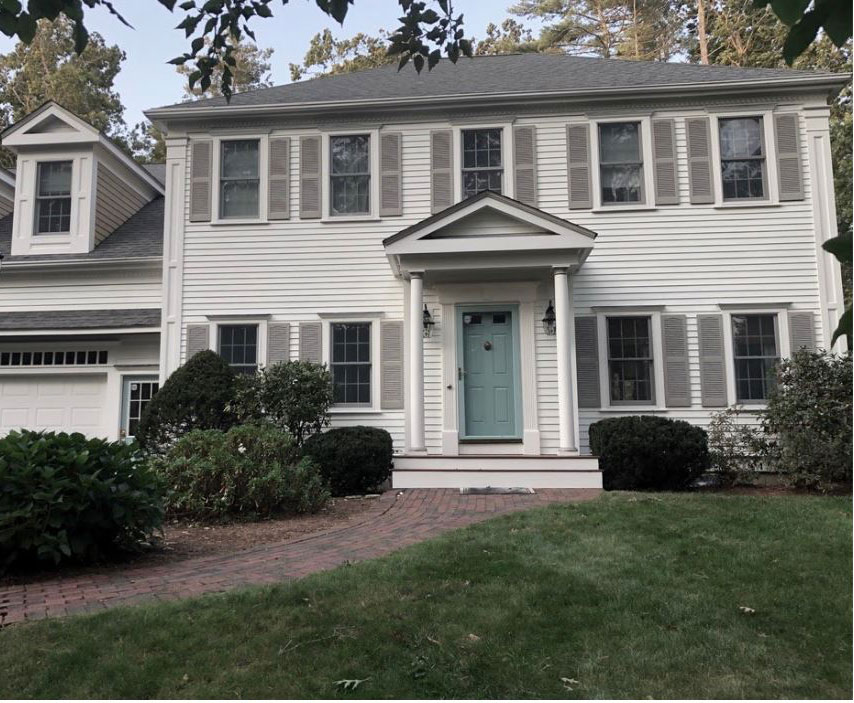
Which should I use on my exterior: Paint or Stain?
Posted on May 15, 2021
Many homeowners understand that exterior painting freshens up the look of their homes, but did you also know that applying exterior paint or stain to their homes protects wood from decay and harsh weather? Let’s dig in:
Staining and painting not only beautify your home but also protect it.
New England’s climate is notoriously harsh to our houses. Boston summers tend to be hot, causing the sun to fade and degrade our homes. Because our winters are cold, windy, and wet, our homes take even more of a beating. Applying a paint or stain every 5-7 years is integral to maintaining the integrity of the wood on your South Shore and Boston-area home.
What will happen if I don’t paint or stain my wood home’s exterior?
If wood is left raw, it will gray and rot. Painting or staining protects wood siding and trim and prolongs its life.
Which is better for my home’s exterior – paint or stain?
Paint sits on top of the substrate, and stain seeps into it. Here are the pros and cons of using paint versus stain on your Boston-area exterior:
Staining your home’s exterior
Because stain seeps into the wood, it’s more protective than a coat of paint, which is a coating that simply sits on the top of the wood.
Solid stains look almost identical to paint but are more protective of the wood because they seep into the porous wood fibers.

Stain comes in varying degrees of pigments – each shows off the underlying wood a bit differently.
Properties of different types of stains:
Transparent Stain:
Your wood grain shows completely, and a transparent stain will allow the wood to weather to its natural color. Many clients choose this if they want their cedar shingles to weather to a beautiful “Nantucket Gray” on their own, remembering that reapplying a transparent stain is an annual affair.
Semi-transparent stain:
The wood grain shows, but there is now a hint of color—a nice compromise if your wood is in good shape but you still want a hint of color.
Semi-solid stain:
The wood texture still shows, but the wood grain is harder to see.
Solid stain:
This stain has the most pigment, so the wood grain is covered almost completely or completely. This is a good choice if the wood is not in good shape and/or you want your home to look like it was painted. Remember though, any coating, whether stain or paint, will not be able to hide all the imperfections of wood, especially wood that needs replacing.
Never stain or paint over rotted wood – the wood will continue to rot, and the coating might peel or not adhere.
Stains tend to wear off gradually, while paint can peel or flake off because it sits on top of the wood.
The appearance created with stain brings out the natural grain and patterns in the timber.
Staining bare wood:
If you have bare wood, you are starting afresh and can choose any stain you want, depending on the amount of pigment, color, and protection you want the wood to have.
Good idea: Stain “all six sides” of any wood you’re installing, including the cuts and underside of the wood to offer more protection to the wood.

Staining over the previously stained wood:
If your home is currently stained, it’s easiest to stick with the level of pigment you already have. Penetrating stains can’t be applied over a film, so stick with the same level of pigment you had before or go darker.
Staining over oil-based stains:
Water-based stains will cover over oil-based stains you’ve previously applied, but oil-based stains cannot be applied over water-based stains.
Can I stain over paint?:
Most people who have a painted house keep painting it to maintain it, but if your house has many coats of paint on it, we become concerned with the weight of the paint. If the paint becomes too heavy, it may “unbond” from the wood, and the thick paint coatings could fail. Therefore if we paint another two coats over a thick layer of existing paint, this “bundle” of paint may become even heavier and fail or un-bond from the wood. In these instances, we might consider adding stain over the paint. While the stain will not absorb into the wood (the paint film will prevent this), the thin pigment of the stain will act as a thin color coating over the existing “heavy” layers of paint.
If you need to stain something that has been painted to reveal the wood grain again, we can chemically or mechanically remove the paint before applying the stain. This is an expensive and time-consuming process that might be considered for a historic home renovation or if a homeowner wants to uncover the wood grain on a beautiful front door.
How can I tell if what’s been painted before is paint or stain?
- f the finish has a sheen, it is more likely a paint. Old stains do not have a sheen.
- If you notice large pieces of peeling, it is more likely paint. Stains usually fade and wear off or flake when they fail.
- Check the exposed wood areas. If there is discoloration similar to the coating color, it is likely a stain. Stains seep into the wood and give the pores a similar color to the topcoat. Paints adhere to the wood’s surface and will usually peel off, revealing the wood’s natural color underneath.
Two main advantages of stain:

Coating your home’s exterior with paint:
Paint sits on top of the wood and can hide imperfections better than stain can. This means if the wood on your home is old or unattractive, paint will help cover it up. No paint is perfect, though—if your wood needs replacing, paint cannot make it look new.
A coat of paint is only as thick as a piece of paper, so after the paint cures, they will still appear if there are imperfections in the wood beneath the paint.
Paint comes in more colors than stains and comes in various sheens, from flat to glossy.
 We recommend the following sheen for your exterior home, but you are the final decision maker – we’ll paint whatever sheen you like!
We recommend the following sheen for your exterior home, but you are the final decision maker – we’ll paint whatever sheen you like!
Exterior doors: Semi-gloss paint
Exterior trim: Satin paint
Exterior clapboards: Flat or Matte paint
Note: Paint always needs to be applied to surfaces that have been previously primed or painted.
What makes paint glossy?
Simplified, paints are made up of resin (the “glue” of the paint) and pigment (the color).
The more resin in a paint, the shinier the paint is. The resin adds durability to the paint, so the more resin in a paint, the more durable the paint will be.

Over time, as the glossy and protective resin in the paint wears away, what’s left on your home’s exterior is just the (non-protective) pigment. This is why, when it’s time to repaint your home, you can often rub your hand on your home’s exterior, and your hands appear to have chalk. If you’re wondering if your home’s exterior actually needs painting, take our 20-second quiz.
Can I paint over stain?
Yes, painting over stain is very common, and because the paint sits on top of the wood, the previous stain that’s been absorbed into the wood does not get in the way of the paint. The stain that has already absorbed inside the wood fibers might even protect the newly painted wood better than a painted board that hasn’t been previously stained.

How do I know if my house was previously painted or stained?
If your coating is fading, it was likely previously stained. Even if it looks like a solid color, it still is likely stained. Solid stains look like paint.
If your coating is peeling, cracking, or flaking, it was likely previously painted (or incorrectly stained with a solid stain).
Best bet: If you can flake off a piece of the previous coating and bring it to Sherwin Williams (Hanover, Pembroke, Hingham, Quincy, Stoughton, Plymouth, Braintree), they will be able to examine it to see if the coating is paint or stain.
What type of wood are you coating?
Soft woods, like pine and cedar, easily accept any penetrating stain. Other woods are more finicky. Before staining, you should apply a test patch to understand exactly how the stain will look on the wood.
Important: the more porous the type of wood or surface you’re staining, the more stain you will need to coat the surface thoroughly.
How worn or old is the wood on your home or deck?
You may need to help hide its imperfections on older wood. Therefore, you may choose a (solid or semi-solid) stain with more pigment or decide to paint it to help hide the wood’s imperfections completely. Again, if a piece of wood is ugly, painting or staining it will not hide all of the imperfections—that wood probably needs to be replaced.
Important: You should never paint over wood rot. Any rotted wood needs to be replaced before coating it. If you are replacing wood, take the time to coat all six sides of the wood (including cut ends) to protect it best.
How many coats of new stain should I apply over the old (faded) stain?
If you confirm that the previous coating is a solid acrylic stain and it seems to have held up well, with only minimal flaking and fading, then it’s a good idea to reapply using Sherwin Williams Woodscapes solid acrylic stain in the new color of your choice. When opting for a new color, it is recommended to apply two finish coats after completing the necessary preparation.
I’m ordering new doors – should I order a pre-primed or factory-finished door?
Factory-finished doors are quite durable and will last a long time, so go ahead and order the door with a factory primer or primer plus a finish coat. If the finish paint doesn’t come in a color you like, order a pre-primed door, and we can finish it with the color you prefer.
How do you prepare the surface for stain?
Before starting the staining process, thoroughly clean the surface using a mold-killing detergent to remove dirt, mold, algae, chalking, or other debris.
After cleaning, ensure that the surface is completely dry before proceeding.
If the coating has peeled in any areas, you’ll need to prep by scraping, sanding, and feather sanding back to the stable existing coating before locally priming with the stain.
Does it matter what color stain I choose?
Darker colors will fade faster than lighter ones.
To ensure that you are satisfied with the color, it’s important to test it on the wall first before buying the full amount. This will allow you to see if you like the color in the lighting that you will encounter. Perform a test patch in an inconspicuous location.
You may have to apply 2-3 coats to reach the desired color.
I’m still confused; how do I know what to choose for my home’s exterior? Paint or stain?
If you want an expert opinion, one of our expert estimators can visit your home and specify the correct stain or paint formula for your unique project and vision.
If you’re doing the project yourself and want a professional opinion (for free), email [email protected] with some photos, and we’ll give you our 2 cents.
< BACK TO OUR INDEX OF ARTICLES, TIPS, AND ADVICE
You also might like:
20-second quiz: Does my home’s exterior need painting or staining right now?
Choosing a color that’s historically accurate for your exterior paint or stain





